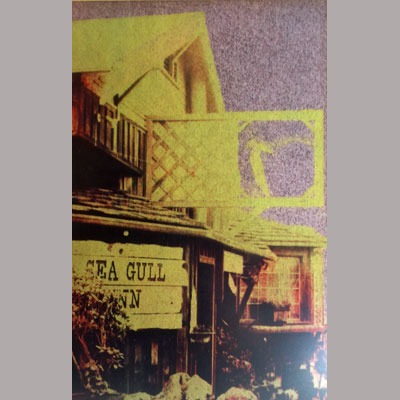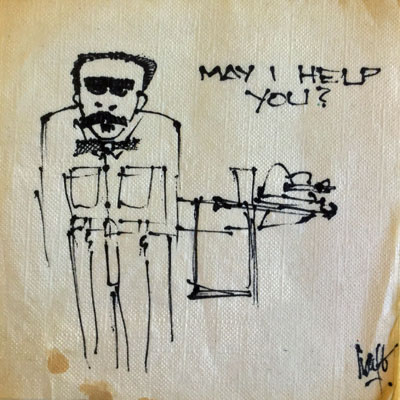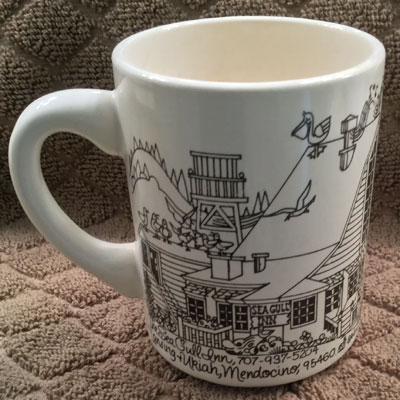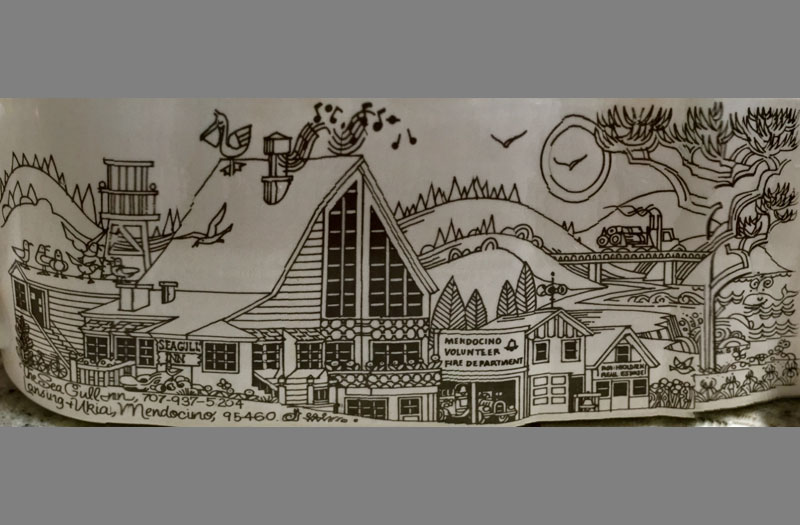Panorama photo of Martin Schmidt’s coffee art by Krissy Jones
Farmer Brothers locked up the restaurant market by loaning out equipment—stainless cabinets, brewing machines, pots, and other essential accessories. The policy helped cash-poor restaurateurs by saving them from tying up their capital in supplies and equipment. The catch—a promise of exclusivity.
For some of the Sea Gull regulars, Farmer Brothers coffee was just fine. They didn’t come for the coffee but for the conversation. Locals sat in the coffee shop around a large round table or in the stools along the two counters nursing the same cup of coffee with endless refills while they argued about politics and work or blathered on about the local news. A stronger coffee would have upset their stomachs not to mention their intestinal tracts.

Photo by Michael Conn
The Sea Gull coffee shop was a mix of Mel’s Diner as portrayed in the 70s TV show Alice and the antique shop in the 80s movie Gremlins where Rand Peltzer bought the mysterious mogwai as a Christmas present for his son Billy. The regulars consisted of hard working straight thinking folks and long haired counter-culture types. They sat side by side. The rednecks preferred the Farmer Brothers coffee. The hip crowd wanted me to carry the local artisanal brand, Thanksgiving Coffee.
The problem I faced was how to keep Farmer Brothers from removing all that free equipment while offering Thanksgiving Coffee as a second choice.
The Farmer Brothers deliveryman, Rich, was a shy and handsome young man who made the waitresses swoon. He was aware of his charms. I knew he enjoyed the attention, and I knew I could use this to win him over to my side. With a little careful maneuvering, I was able to take advantage of the subtle sexual dance between Rich and the waitresses. Rich accepted the idea of offering Thanksgiving Coffee as a second choice because he got personal satisfaction (non-monetary rewards) from delivering coffee to the Sea Gull. It wasn’t just business for him, but the business couldn’t be ignored. I told him Farmer Brothers would be the default brand. I assured him sales of Thanksgiving coffee would be minimal and by request only. I was not required to keep records on which coffee was most popular. We sold a lot of coffee, hundreds of cups a day. He got his share. The waitresses continued to swoon. Rich always showed up. Farmer Brothers was none the wiser

Sea Gull Cellar Bar Napkin Art, artist Jack Haye
Offering two coffees sometimes led to humorous situations. I remember one occasion when a tourist waved me over to her table.
“Excuse me, Sir, but is this some kind of religious institution?”
“Religious? No, what makes you think that?”
“Well, I’ve noticed the waitresses start by saying Thanksgiving when they arrive at the table. The customers wave their heads as if they’re in a sort of bliss. It’s rather peculiar. I’ve heard of restaurants run by religious groups. It doesn’t offend me. I was just curious.”
“Oh, that.” I smiled. “We have two types of coffee. Our regular coffee, the default brand, is Farmer Brothers, but we always ask if the customer prefers Thanksgiving Coffee instead. Thanksgiving Coffee is a local company. Their coffee is a little stronger and some think more flavorful.”
The woman seemed satisfied with the explanation. She asked if she could try the Thanksgiving coffee, and I happily obliged. I hoped Rich didn’t have a spy in the coffee shop counting the cups of Thanksgiving coffee that were served that day.

Sea Gull Coffee Cup, artist Martin Schmidt
Like many restaurants, we sold items at the register to make a few extra bucks. A customer is most vulnerable when the cash is already out of their wallet, especially if they’ve just enjoyed a good meal. A pound of Thanksgiving Coffee was a local product they could take home to celebrate their trip, easily transported and relatively inexpensive.
I chuckled to myself one day when I heard a woman tell her husband: “Look honey, they sell the same coffee up here that we buy at home in Los Angeles.” She was unaware that the coffee was roasted just a few miles up the road.
To go with the coffee we sold coffee cups imprinted with an original drawing of the Sea Gull by local artist Martin Schmidt. We sold hundreds of these cups and could never keep them in stock. We also sold kelp pickles (both sweet and dill) that were harvested, prepared, and preserved in canning jars locally at Antioch Ranch.
We sold the antiques, paintings, and musical instruments that decorated the walls and logo t-shirts—anything to boost sales especially during the winter when it was difficult to make the payroll. I’d run the stock down to zero every week to free up the dormant cash sitting on the shelves, an early example of just-in-time inventory management.
Another way I put my knowledge of economic theory to practical use was to test what economists call the price elasticity of demand. I didn’t want to raise menu prices across the board but I needed to do something creative to bring in a few extra bucks because costs were going up. This was the 1970s, an historical period described by an ugly word that lacked any sense of imagination—stagflation. I worried that raising menu prices would reduce total sales by causing unit sales to drop, offsetting the impact of higher prices. Restaurant dining was thought to be price elastic. However, my guess was that raising coffee prices wouldn’t have much of an impact on unit coffee sales so that actual sales would rise. My little experiment proved that the demand for coffee was inelastic, at least in the relevant price range for my purposes.
There have been very successful corporations based on this same idea. But, I my business goals were modest. The Sea Gull Coffee shop was what made the restaurant special and successful. I knew I could always find a carpenter, an electrician, or a plumber when I needed one or an artist or a writer if I needed a poster or an advertisement. Rednecks and hippies sat together and had their conversations. Even the tourists enjoyed mingling with the locals in the coffee shop. Whatever their differences outside the restaurant, inside they were one big family.


Good story. I remember those times in the coffee shop. Also, I liked all of Martin Schmidt’s art work.
Your story and the picture of the cup bring back so many memories. Whenever I walk past the building, I wish the Sea Gull would reappear. Thank you David, and also Marlene and Martin, for years of the Sea Gull.
I miss it all too. Thanks Susan. You’d be happy to know that the piano you encouraged us to buy ended up with my oldest grandson who is turning into quite a musician, actor and dancer. David
There was nothing better to start the day than load Roscoe ( my dog ) into the truck and head into town and have breakfast at the Seagull every morning. For me this was the heart and soul of the town, and a jump start on the day.